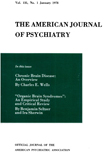A STUDY OF 138 ELDERLY FIRST ADMISSIONS
Abstract
From the data presented, we have drawn the following conclusions:
1. The first hospitalization is very useful for most mental patients over 65 years. The median stay was 42 days.
2. One year post admission, 19% were dead, 48% were home, and 39% were able to care for themselves physically.
3. Total follow-up, ranging from 2 years, 2 months, to 7 years, found 42% dead, 39% at home, 33% able to care for themselves.
4. Physical impairment was related to the admission directly in 50%, indirectly in 11%, and was unrelated in 37%. The medical impairment status on admission correlated with the final outcome in terms of mortality.
5. There is a marked discrepancy in diagnostic categories between patients from this hospital and state hospital systems. Some of this is due to differences in social class, but not all. The percentage of affective reactions is especially striking—45%.
6. The single most important factor in decreased mortality is treatment of the patient as a total psychobiologic unit. The intermingling of elderly patients with the total patient group may be important therapeutically.
Access content
To read the fulltext, please use one of the options below to sign in or purchase access.- Personal login
- Institutional Login
- Sign in via OpenAthens
- Register for access
-
Please login/register if you wish to pair your device and check access availability.
Not a subscriber?
PsychiatryOnline subscription options offer access to the DSM-5 library, books, journals, CME, and patient resources. This all-in-one virtual library provides psychiatrists and mental health professionals with key resources for diagnosis, treatment, research, and professional development.
Need more help? PsychiatryOnline Customer Service may be reached by emailing [email protected] or by calling 800-368-5777 (in the U.S.) or 703-907-7322 (outside the U.S.).



